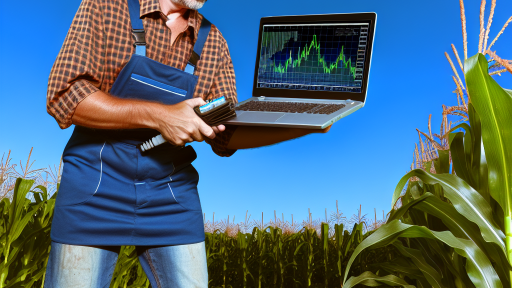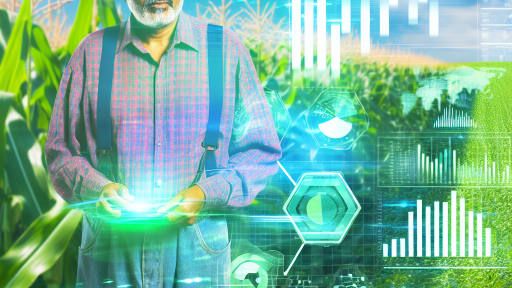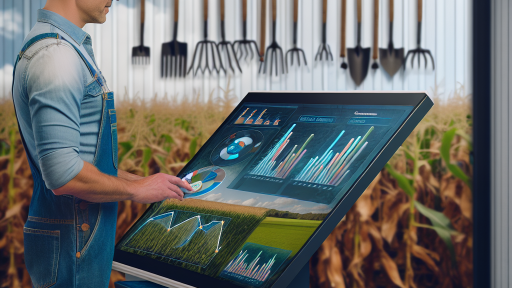Introduction to Smart Farming and the Importance of Data-Driven Analysis
Smart farming revolutionizes agricultural practices through technology.
This approach enhances productivity and sustainability.
Data-driven analysis plays a crucial role in smart farming.
Farming is becoming increasingly complex due to various factors.
Data helps farmers make informed decisions in real-time.
The Role of Technology in Smart Farming
Technology provides tools that monitor crop health.
Drones and sensors collect valuable data from fields.
This information allows for precise applications of resources.
Moreover, it enhances yield predictions and pest management.
Benefits of Data-Driven Analysis
Data-driven analysis promotes efficiency in farming operations.
Farmers can identify trends and patterns through data.
Additionally, it aids in resource allocation and risk management.
Farmers enjoy improved sustainability through informed practices.
Challenges in Implementing Data-Driven Practices
Despite the benefits, challenges remain in data implementation.
Data accuracy is essential for effective decision-making.
Transform Your Agribusiness
Unlock your farm's potential with expert advice tailored to your needs. Get actionable steps that drive real results.
Get StartedFurthermore, technology adoption may require significant investment.
Farmers must also be trained to interpret data correctly.
The Future of Smart Farming
The future of smart farming looks promising with emerging technologies.
Artificial intelligence is set to enhance data analysis capabilities.
Additionally, machine learning can predict better outcomes.
Farmers will benefit from continuous advancements in technology.
Ultimately, data-driven analysis will shape the future of agriculture.
Key Data Sources for Market Analysis in Smart Farming
Government Agricultural Data
Government agencies provide valuable agricultural statistics.
The United States Department of Agriculture (USDA) is a primary source.
USDA reports cover crop production, market trends, and regional data.
Moreover, national agricultural surveys offer insights into farming practices.
These reports can significantly inform market analysis decisions.
Industry Reports and Market Research Firms
Market research firms publish comprehensive industry analysis.
Reports from companies like Technavio and MarketsandMarkets are insightful.
These reports often provide forecasts and industry trends.
Additionally, they highlight consumer behavior patterns.
Investors and farmers can leverage this information for strategic planning.
Academic Research and Publications
Universities often conduct innovative research in smart farming.
Academic journals publish studies on agricultural technologies.
These publications can reveal emerging trends and technologies.
Research findings assist farmers in adopting best practices.
Accessing academic databases can enrich market analysis efforts.
Sensor Data from Smart Farming Technologies
Smart farming technologies generate invaluable data through sensors.
Soil moisture sensors provide real-time soil condition insights.
Showcase Your Farming Business
Publish your professional farming services profile on our blog for a one-time fee of $200 and reach a dedicated audience of farmers and agribusiness owners.
Publish Your ProfileClimate monitoring technologies track weather conditions affecting crops.
This data allows for precise decision-making in farming practices.
Additionally, it helps mitigate risks associated with crop production.
Social Media and Online Platforms
Social media serves as a modern platform for gathering insights.
Farmers often share experiences and tips through online forums.
Analyzing these conversations can uncover market trends.
Also, platforms like LinkedIn connect agricultural professionals.
This networking can lead to collaboration opportunities.
Marketplaces and E-commerce Data
Online marketplaces provide sales data related to agricultural products.
Analyzing transactions can reveal price trends and consumer preferences.
Platforms like Farmer’s Business Network offer transparency in pricing.
Furthermore, e-commerce analytics can drive effective marketing strategies.
Utilizing this data enhances competitive advantage in the market.
Tools and Technologies for Collecting Agricultural Data
Remote Sensing Technologies
Remote sensing technologies provide invaluable data about agricultural areas.
These tools collect information via satellite or aerial imagery.
Farmers can analyze crop health and soil conditions accurately.
Additionally, remote sensing helps in monitoring irrigation systems.
IoT Devices in Agriculture
IoT devices transform farming by collecting real-time data.
These devices include soil moisture sensors and weather stations.
Farmers can track environmental conditions efficiently.
Moreover, IoT devices enhance decision-making processes.
Data Analytics Platforms
Data analytics platforms simplify the collection and analysis of agricultural data.
These platforms integrate various data sources effectively.
Farmers can visualize trends and make informed decisions.
As a result, crop yields can significantly improve.
Drones for Precision Agriculture
Drones are revolutionizing precision agriculture practices.
They provide high-resolution images of fields quickly.
Farmers can use drones for monitoring crop growth and health.
This technology also aids in targeted pesticide spraying.
Mobile Applications for Data Gathering
Mobile applications facilitate quick data entry and access.
Farmers can input field data directly using their smartphones.
These apps help in tracking planting schedules and weather alerts.
Furthermore, they encourage collaboration amongst agricultural stakeholders.
Discover More: Navigating Commodity Price Fluctuations in Farming
Analyzing Market Trends Using Predictive Analytics in Agriculture
Introduction to Predictive Analytics
Predictive analytics utilizes statistical techniques to analyze data.
It predicts future trends based on historical data.
This approach enhances decision-making in agriculture.
Importance of Market Trends in Agriculture
Understanding market trends helps farmers respond effectively.
It allows for informed decisions regarding crop selection.
Additionally, it optimizes resource allocation and management.
Showcase Your Farming Business
Publish your professional farming services profile on our blog for a one-time fee of $200 and reach a dedicated audience of farmers and agribusiness owners.
Publish Your ProfileCollecting Data for Analysis
Data collection is the first step in predictive analytics.
Farmers can gather data from various sources.
These include weather patterns, soil conditions, and market prices.
Advanced sensors and IoT devices facilitate real-time data collection.
Applying Predictive Analytics
Once collected, data undergoes analysis using algorithms.
Machine learning models can reveal hidden patterns.
For instance, farmers can predict crop yields and market demand.
This helps in strategic planning and risk management.
Case Study: Successful Implementation
Agricultural Co-op Solutions implemented predictive analytics.
They analyzed three years of crop yield data.
The results informed future planting strategies.
As a result, members increased yields by 20 percent over two seasons.
Challenges in Data-Driven Analysis
Despite its benefits, predictive analytics faces challenges.
Data accuracy is crucial for effective predictions.
Additionally, technical expertise is required to interpret results.
Farmers may need training to utilize these technologies effectively.
Future of Predictive Analytics in Agriculture
The future looks promising for predictive analytics in agriculture.
Innovative technologies continue to emerge, enhancing capabilities.
As more farmers adopt these tools, market trends will become clearer.
This transformation has potential benefits for global food security.
Delve into the Subject: How Vertical Farming Is Disrupting Traditional Agribusiness Models
Case Studies: Successful Implementation of Data-Driven Market Analysis in Smart Farms
Introduction to Smart Farming
Smart farming utilizes technology to enhance agricultural productivity.
This approach combines data analysis with modern farming practices.
Farmers adopt smart practices to maximize yield and efficiency.
Case Study: Green Fields Farms
Green Fields Farms implemented data-driven analysis to optimize crop selection.
They used satellite imagery and soil sensors to gather information.
This data informed their decisions on organic fertilizer application.
As a result, they improved yield by 30% over three growing seasons.
Key Technologies Used
- Satellite imagery for monitoring crop health.
- Soil moisture sensors for irrigation management.
- Climate data analytics for forecasting yields.
Lessons Learned
Timely data is essential for effective decision-making.
Investing in technology pays off in the long term.
Collaboration with tech partners enhances farming strategies.
Case Study: AgroTech Solutions
AgroTech Solutions employed big data analytics to assess market trends.
They analyzed consumer demands to adjust their production schedules.
This strategic approach minimized waste and increased profitability.
Data Analysis Strategies
- Customer trend analysis through social media insights.
- Market forecasting based on historical sales data.
- Competitor benchmarking to identify market opportunities.
Outcomes Achieved
AgroTech reported a 25% increase in market share within one year.
They reduced operational costs through efficient resource management.
Smart decisions led to sustainable growth and innovation.
Case Study: TechGrow Farms
TechGrow Farms utilized IoT devices for real-time data collection.
These devices enabled precise monitoring of crop conditions.
They adapted their practices based on actionable insights.
Showcase Your Farming Business
Publish your professional farming services profile on our blog for a one-time fee of $200 and reach a dedicated audience of farmers and agribusiness owners.
Publish Your ProfileImplementation Steps
- Integration of IoT devices for field monitoring.
- Training staff on data interpretation and usage.
- Regular evaluation of data-driven practices for improvement.
Impact on Business
TechGrow enhanced water usage efficiency by 40%.
Crop loss due to diseases decreased significantly.
They established a reputation for sustainable farming practices.
Implications of Data-Driven Practices in Smart Farming
These case studies highlight the effectiveness of data-driven market analysis.
Smart farming practices lead to improved efficiency and profitability.
Ultimately, leveraging technology enables better decision-making in agriculture.
Learn More: How to Scale Your Agribusiness for Maximum Revenue

Challenges in Data-Driven Market Analysis for Farmers
Data Availability Issues
Farmers often struggle to access reliable data sources.
This limitation hinders effective market analysis.
Additionally, data accuracy can vary significantly.
Farmers may rely on outdated information when making decisions.
As a result, they may miss lucrative opportunities.
Technological Barriers
Many farmers lack access to advanced technological tools.
These tools are essential for analyzing market data effectively.
Furthermore, there is often a steep learning curve involved.
Some farmers may feel overwhelmed by data analytics software.
Consequently, they may avoid technology altogether.
Budget Constraints
Budget constraints limit many farmers’ ability to invest in data solutions.
They may struggle to allocate funds for necessary technologies.
This can lead to missed insights and competitive disadvantages.
Moreover, affordable options are often perceived as less effective.
As a result, farmers may hesitate to adopt new strategies.
Data Integration Challenges
Farmers frequently encounter issues when integrating various data sources.
Data silos can lead to fragmented insights into the market.
This fragmentation complicates the decision-making process.
Moreover, without comprehensive data, farmers cannot see the full picture.
It becomes challenging to develop a coherent market strategy.
Changing Market Dynamics
The agricultural market is constantly evolving.
Changes in consumer preferences can impact demand unexpectedly.
Farmers need to remain adaptable to these shifts.
Understanding these dynamics requires real-time data analysis.
However, many farmers struggle to keep up with rapid changes.
Regulatory Challenges
Farmers must navigate a complex web of regulations.
Compliance with data privacy laws can be daunting.
Additionally, regulations can vary widely by region.
This variability complicates data usage and analysis.
Farmers must ensure they adhere to all relevant guidelines.
You Might Also Like: Proven Agribusiness Strategies for Maximum Profit
The Role of Big Data and AI in Enhancing Smart Farming Decision-Making
Introduction to Big Data in Agriculture
Big data revolutionizes the agricultural sector significantly.
It offers farmers insights into their crops and soil conditions.
Showcase Your Farming Business
Publish your professional farming services profile on our blog for a one-time fee of $200 and reach a dedicated audience of farmers and agribusiness owners.
Publish Your ProfileMoreover, it helps optimize resource allocation efficiently.
Artificial Intelligence in Farming
AI enhances decision-making in farming operations.
It processes large datasets to predict yields accurately.
Additionally, AI assists in identifying crop diseases early.
Data Collection Techniques
Farmers now utilize various techniques for data gathering.
Sensors and drones collect real-time data from fields.
This data includes information on weather, soil health, and crop growth.
Data Analysis and Interpretation
Analyzing data is crucial for effective decision-making.
Farmers can decipher trends and patterns with advanced analytics.
Such insights enable more informed planting and harvesting times.
Impact on Crop Management
Smart farming methods lead to improved crop management.
With data-driven decisions, farmers enhance their yields.
Furthermore, they minimize waste by optimizing inputs like water and fertilizers.
Case Studies of Successful Implementations
Several farms have successfully adopted these technologies.
For example, GreenFields utilized AI algorithms to increase yield by 20%.
Additionally, FreshHarvest implemented a data analysis strategy that reduced costs by 15%.
Future Prospects of Data-Driven Agriculture
The future of agriculture is closely tied to technology.
Emerging technologies will enhance data collection and analysis capabilities.
Moreover, greater collaboration and data sharing among farmers will lead to collective improvements.
Future Trends in Data-Driven Market Analysis for Sustainable Agriculture
Integration of Advanced Technologies
Farmers increasingly rely on IoT devices and sensors for real-time data collection.
This integration enhances decision-making processes across the agricultural spectrum.
Specifically, drones provide crucial insights into crop health and land usage.
Moreover, AI algorithms analyze vast datasets to identify trends and anomalies.
Such technologies drive precision farming and optimize resource usage.
Personalization of Agricultural Solutions
Data-driven solutions will become more personalized for individual farmers.
Farmers will receive tailored recommendations based on their specific farm conditions.
For instance, custom fertilizers can improve crop yield based on soil analysis.
Additionally, this personalization can optimize pest control measures for unique farms.
Collaboration and Data Sharing
Collaboration among stakeholders is set to increase in the agricultural sector.
Farmers, agronomists, and data scientists will share insights more effectively.
This collaboration can improve overall market analysis accuracy.
Furthermore, shared data can lead to more robust predictive models.
Focus on Sustainability Metrics
Sustainability metrics will gain prominence in market analysis frameworks.
Analysts will consider long-term environmental impacts of farming practices.
Metrics may include carbon footprint, biodiversity, and water usage efficiency.
Such considerations will influence consumer buying decisions and market trends.
Regulatory Changes and Compliance
Future trends will also reflect evolving regulatory landscapes in agriculture.
Compliance with sustainability regulations will shape market strategies.
Farmers will need to adapt their practices to meet these regulatory requirements.
In turn, data-driven analysis will assist in ensuring compliance and transparency.
Showcase Your Farming Business
Publish your professional farming services profile on our blog for a one-time fee of $200 and reach a dedicated audience of farmers and agribusiness owners.
Publish Your ProfileEnhanced Consumer Insights
Consumer demands for transparency will influence agricultural data practices.
Farmers will gain insights into consumer preferences through data analysis.
As a result, they can align their production practices with market needs.
This alignment will ensure that products meet quality and sustainability standards.
Additional Resources
Precision Agriculture: Benefits and Challenges for Technology …
Smart Agriculture Market Size, Share, Industry, Technology and …




